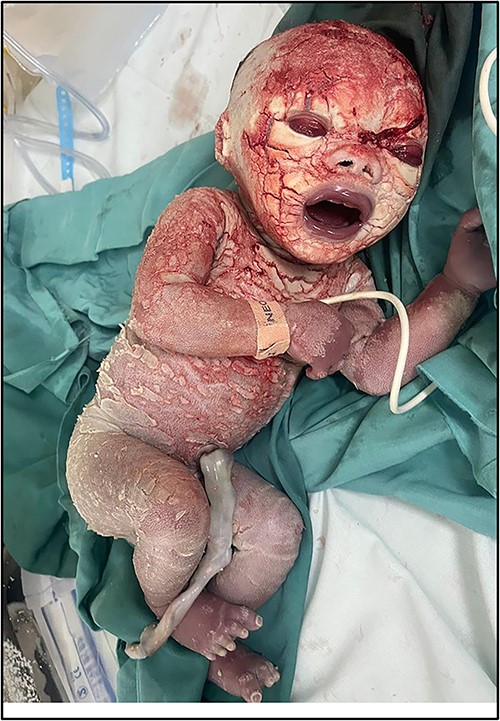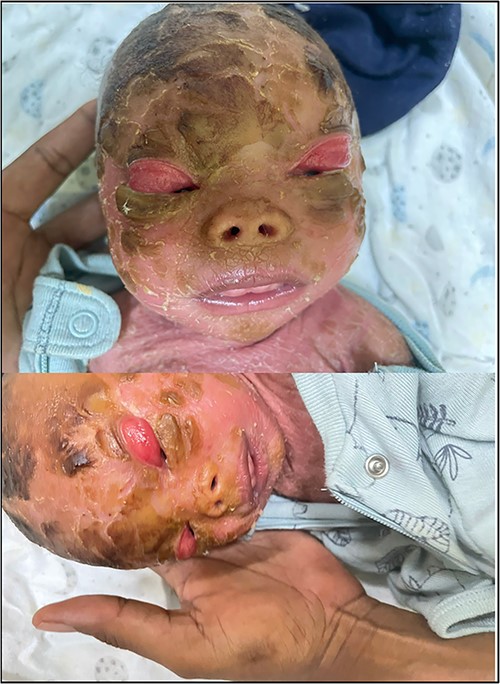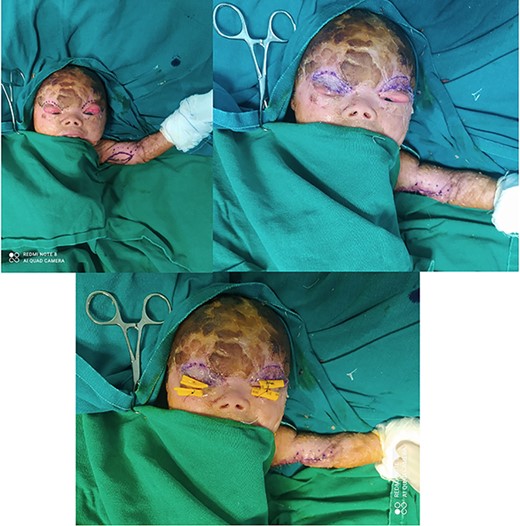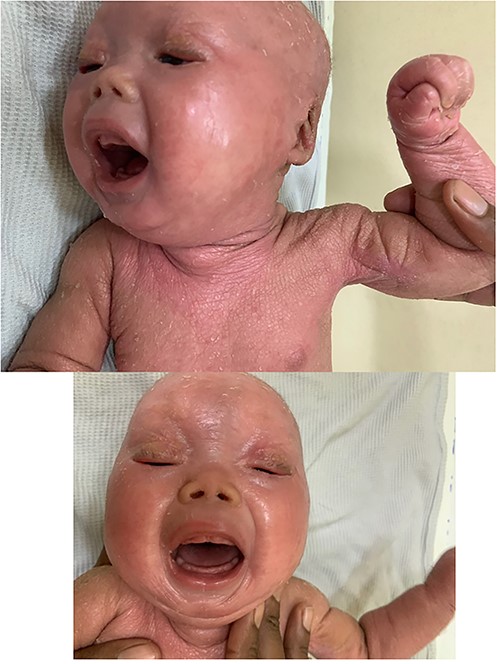-
PDF
- Split View
-
Views
-
Cite
Cite
Miguel Johnson, Caleisia Mowatt, Kimberley Scott, The successful treatment of Lamellar Ichthyosis—a plastic surgeons perspective, Journal of Surgical Case Reports, Volume 2023, Issue 1, January 2023, rjac552, https://doi.org/10.1093/jscr/rjac552
Close - Share Icon Share
Abstract
Congenital Ichthyosis represents a very rare group of congenital skin disorders characterized by some degree of scaling and thickening of the stratum corneum with skin inflammation. Severe forms such as Harlequin and Lamellar forms may present with limb and organ compromise, respectively. Patients with Lamellar subtype presents with severe ectropion which may lead to corneal ulceration, rupture and blindness. Treatment includes a multidisciplinary approach allowing for early intervention and treatment, which optimize the outcomes. The timing for intervention is not clearly defined in the literature. This is most likely due to a paucity in data due to the relative infrequency in these conditions. However, using principles similar to early treatment of ectropion in burnt patients may be employed. A case of Lamellar Ichthyosis that presented to our outpatient clinic which was successfully managed with early ectropion release and full thickness skin graft is discussed.
INTRODUCTION
Congenital Ichthyosis represents a very rare group of monogenetic disorders of cornification. This may be associated with systemic symptoms [1]. The clinical features vary significantly from mild to severe forms but invariably involves some degree of scaling and thickened stratum corneum with skin inflammation [1]. Less common features include pruritus, skin fragility, ectropion and anhidrosis, which tends to be associated with rare types.
This group of disorder may present in mild forms, which typically requires topical agents such as emollients for treatment. However, more severe forms, which may result in limb and organ loss commonly requires timely surgical treatment salvage organ, limb and life. The Harlequin subtype may present with several constrictive plaques encircling the limbs with decreasing limb perfusion. Whereas, in the Lamellar subtype, patients may develop severe ectropion, corneal perforations and eventual blindness [1].
Early recognition and surgical management are paramount to the survival and salvaging of limbs and eyes [1, 2]. Most importantly, when dealing with patients with Congenital Ichthyosis the timing of surgical intervention is of utmost importance to achieve optimal outcomes. Although the non-operative treatment for this group remains well established, the surgical intervention is less documented. Several concerns exist which includes the ideal timing for surgical intervention, ideal donor site for harvesting of full thickness skin grafts and whether these patients have impaired wound healing ability due to their skin conditions.
We present a case of a patient with Congenital Ichthyosis that demonstrated severe ectropion bilaterally with scaling of the entire body who was successfully managed by a collaborative treatment between ophthalmologist, dermatologist and plastic surgeons. Treatment included early intervention using full thickness skin grafts harvested from the medial arm.
CASE REPORT
A 17-day-old male neonate presented to our local outpatient clinic following a referral from our ophthalmological colleagues with a history of severe bilateral ectropion. The child was born at 36 weeks via a caesarean section due to fetal bradycardia to a 35-year-old mother G2P1 mother with normal booking parameters. Her pregnancy was uncomplicated. Anomaly scan done at 20-week gestation was reportedly normal.
At birth, the child was noted to have significant scaling of the entire body, severe bilateral ectropion and flattened posteriorly rotated ears consistent with a presentation of Lamellar Ichthyosis (Fig. 1). His APGAR scores at birth were eight at 1 min and nine at 5 min. He was discharged home Day 1 of life on emollients, moisturizing eye drops and gel.

Image showing severe dry scaly patches throughout skin. Note bilateral ectropion.
At presentation to the outpatient department, findings were similar to that noted at birth, however there were some improvements in the scaling of the skin. Significantly, we noted worsening of lid ectropion. The child was unable to close the eyes, however there was no corneal abrasions (Fig 2).

Image showing patient at 17 day of life. Note worsening of ectropion bilaterally.
An urgent ectropion release and full thickness skin grafting was undertaken. Following release of ectropion, full thickness skin was harvested from the right medial arm under general anesthesia at Day 23 of life. The lids were then partially closed using Frost sutures over a rubberized tube from a sterile urinary catheter (Fig. 3). Postoperatively, the patient did well and there was complete correction of bilateral ectropion (Figs 3 and 4).

Image showing planned surgical incision site for release of ectropion, followed by harvesting of skin graft, insetting and placement of Frost suture.

DISCUSSION
Congenital Ichthyosis represents a rare group of disorders characterized by varying degree of cornification. These disorders are thought to be due to mutations in the ABCA12 gene in an autosomal recessive pattern [2, 3]. Mutation of this gene causes defective lipid deposition within the stratum corneum of the epidermis, clinically manifesting as extreme hyperkeratosis [2]. The most common form of ichthyosis is ichthyosis vulgaris, followed by X-linked ichthyosis [4]. Ichthyosis vulgaris has a reported incidence of 1/300 live births, whereas X-lined Ichthyosis has an incidence of 1/2500.
Less common forms of ichthyosis include Harlequin Ichthyosis and Lamellar Ichthyosis with incidence of 1/100 000 [1].
Traditionally, it was thought that these patients had a high mortality rate, however with improvements in care and advancement in medicine, these patients survive longer and lead a ‘normal’ life. A recent review by Rajpopat et al. demonstrated of a total 45 cases of Harlequin ichthyosis there was an overall survival rate of 56%. They found that death tended to occur within the first 3 months and was attributed to sepsis and/or respiratory failure in 75% of cases [5].
Harlequin ichthyosis is a subtype of congenital ichthyosis (CI). It is a very rare but severe form of CI [3]. It is characterized by thickened scaly plaques, which are usually separated by deep fissures. These plaques may involve the entire body from head to toe with sparing of the penis or skin folds and creases [6]. Less commonly, these cases may involve the entire body without sparing such as seen in our case.
Congenital Lamellar Ichthyosis is another rare subtype of ichthyosis that presents similar to Harlequin ichthyosis and is characterized by mild erythroderma and extensive, fine, dark and flat scales that covers all the body surface. It is often associated with severe ectropion as seen in Fig. 1. The ectropion exposes the cornea and invariably may result in corneal abrasion and ultimately rupture and blindness [7].
The timing for intervention is not clearly defined in the literature. This is most likely due to a paucity in data which in part may be due to the relative infrequency in which these conditions are seen. We propose using basic principles similar to the management of traumatic ectropion secondary to burns. Early intervention has been shown to yield excellent results and mitigate against corneal abrasion [8, 9]. Releasing incisions were made down to orbicularis oculi. This provided an ideal recipient bed for a thin full thickness graft, harvested from the medial arm. Frost sutures then allowed for excellent graft take and mitigated against further ectropion as the wound healed [10].
CONCLUSION
Congenital ichthyosis represents a group of rare disorders characterized by thickening of the epidermis of the skin. Patient may present with rare variants that involves thickened scales that may compromise limbs. In addition, variants such as lamellar subtypes commonly present with severe ectropion. A multidisciplinary approach by dermatologist, ophthalmologist, ENT and plastic surgeons is warranted to provide timely intervention thereby allowing for limb and eye salvage.
CONFLICT OF INTEREST STATEMENT
None declared.
FUNDING
None.



